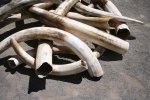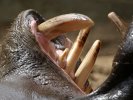Ivory is basically dentine which is the material which makes up the teeth of all mammals. From a commercial point of view, ivory can be the tusk of elephants, walrus, narwhal or the teeth of a hippopotamus. It is the elephant tusk which is the most valuable.
South African elephant tusk is smaller in size and less strong as compared to Indian elephant tusk and it is of course illegal to trade elephant tusk as prohibited by laws.
































Leave a Reply
You must be logged in to post a comment.